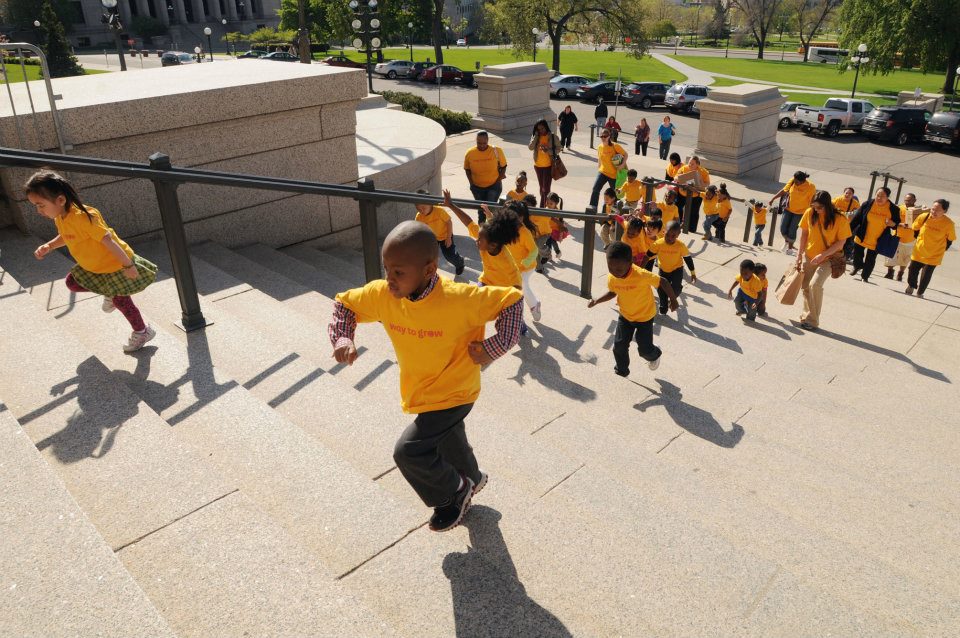Over the last four years, Gov. Mark Dayton has pioneered the use of flexible, empowering and portable scholarships to help low-income children access quality early education, as measured by the Parent Aware Ratings. His early learning scholarships allowed low-income families to take their scholarships to any quality provider, be they based in schools, homes, or centers, and even take the scholarship with them when the parents’ job or home changed.
This pilot-tested approach helped Minnesota win a highly competitive national grant for $45 million. It earned the support of the broad-based MinneMinds Coalition, the Minnesota Business Partnership, and a bipartisan group of legislators. It was even prominently featured in the governor’s re-election campaign ads.
Most important, the current approach successfully moved thousands of Minnesota kids into quality early learning settings in a cost effective manner, and incented hundreds of providers to prove and improve their quality. At long last, Minnesota has seen its rate of kindergarten-readiness begin to improve.
But for some reason, the Dayton administration is now proposing to take a much less effective and much more costly approach. Instead of targeting efforts on at-risk children, generating an extraordinary public return, the state would subsidize all children (families at all income levels), generating little return for a large portion of that investment.
And instead of continuing to provide an equal opportunity for all quality providers to serve children using state funding, the new proposal would earmark state funding for school-based programs only, to the exclusion of quality center-based and home-based programs.
(The proposal technically allows a school district to deem a non-school program(s) eligible if several extraneous new requirements are met. But even then, the school district is given total control of the funding, and it seems highly unlikely that many, or any, school districts would be willing to forfeit their earmarked funding.)
While the governor deserves applause for championing expanded access to quality early learning, I urge him to reconsider his support for the schools-only model for the following reasons:
1. Spending on the non-poor doesn’t focus on the achievement gap. The current scholarship-based approach targets limited state funding to low-income children, because they are the most likely to start kindergarten behind and fall into the K-12 achievement gap. Research I and others have conducted clearly shows that investing in helping low-income children access high-quality early education delivers by far the highest return-on-investment. The proposed new approach would fund all families, even wealthy families, which research shows is a relatively poor use of tax dollars. With many societal needs competing for limited tax dollars, low-income children should be helped first with scholarships and evidence-based home visiting beginning prenatally, before we fund pre-K for non-poor families. If Minnesota leaders are truly serious about the achievement gap, we need to help low-income kids first and fully.
2. Schools-only earmarking locks taxpayers into the most expensive approach. School-based programs absolutely should be one of the options available to parents. Currently, it is a popular choice, and it serves children well. But one factor we do need to keep in mind is that school-based programs are also a relatively expensive way of delivering early education. In 2011, the Rand Corporation did an analysis in Minnesota of the cost per child for every hour of 3- or 4-star Parent Aware rated early education. Rand found that school-based programs were the most expensive approach ($19.06 per hour), and were significantly more expensive than high-quality programs based in Head Start ($10.36 to $14.06), for-profit centers ($3.47 to $5.77 per hour), nonprofit centers ($9.21 to $11.94 per hour), and homes ($3.52 to $4.15 per hour). Again, school-based programs should continue to be one option available to parents, but it makes no sense to mandate that taxpayers fund only the most expensive method of delivering high quality early education.
3. Schools-only earmarking is fundamentally unfair to hundreds of Minnesota’s quality programs and the kids they serve. The governor’s schools-only proposal assumes that kindergarten-readiness best practices can only be delivered in school-based programs. But under the model the governor has used over the last four years, hundreds of centers and home-based programs have proven that they also can adopt the best practices. These providers were promised that if they adopted these best practices, they would have an equal opportunity to compete for the business of state-funded families. But the new model replaces the governor’s equal-opportunity model with a schools-only earmarking model, and that earmarking model is grossly unfair to hundreds of quality early education providers and the children they are serving.
4. Schools-only earmarking dramatically shrinks quality improvement incentive. Under the governor’s 2011-2015 approach, hundreds of child-care providers of all types and sizes have volunteered to adopt kindergarten-readiness best practices. Why? In part because doing so has earned them rewards, such as the business of the growing number of Minnesota families with state-funded early learning scholarships. Those scholarships are a powerful “carrot” to incent providers to adopt best practices. But once you take 4-year-olds out of the reward set, a major quality improvement incentive is removed. That almost certainly means that fewer providers will volunteer to adopt kindergarten-readiness best practices, and that is bad news for Minnesota’s 0- through 5-year-olds who need a robust supply of quality child care and early education options.
5. Schools-only earmarking is less flexible for parents and kids. Under the current approach that has been used the last four years, parents can choose the program that best fits their child and their life circumstances. But under the proposed new model, parents would be required to use a school-based program. Therefore, parents would no longer be able to shop around to find the program that is most sensitive to their culture, is near their home or job, and/or is using a teaching approach that particularly fits their child.
Dayton has had it right with his 2011-2015 models of early education scholarships, which is why it has earned broad support. He deserves a lot of credit for what he has done over the last four years. So if Minnesota’s current early education model isn’t broken, why try to “fix it” with a revised schools-only mandate that is much more costly and much less effective?
Art Rolnick is a former economist at the Federal Reserve Bank of Minneapolis and a current senior fellow at the University of Minnesota Humphrey School of Public Affairs. He serves on several boards including the boards of Way to Grow and Parent Aware for School Readiness.
This article originally appeared in MinnPost and is republished with permission of the author.



